| Article ID | Journal | Published Year | Pages | File Type |
|---|---|---|---|---|
| 10236167 | Process Biochemistry | 2005 | 6 Pages |
Abstract
Bath wastewater is an ideal wastewater-reclamation source for its large discharge amount, simple pollutant composition and low pollutant content. The feasibility of reclaiming bath wastewater with a membrane bioreactor was investigated in a pilot plant of 10Â m3 per day at an organic load of 0.50-1.85Â kg-COD/(m3 per day). The operation was continued for 216 days without sludge discharge and chemical cleaning of membrane modules. The quality of the effluent obtained met the wastewater reclamation standard of China, with COD<40Â mg/l, NH4+âN <0.5Â mg/l and anionic surfactant (AS) <0.2Â mg/l. Biological treatment removed most pollutants in the influent, degrading 34-85% of COD and 98% of anionic surfactant. The membrane separation balanced the unstable biological treatment of COD but demonstrated no contribution to anionic surfactant removal. Inorganic substances were found to accumulate in the bioreactor. The main reason for membrane fouling was considered to be sludge adhesion and gel layer formation over the outer membrane surface and microbial growth over the inner membrane surface.
Keywords
Related Topics
Physical Sciences and Engineering
Chemical Engineering
Bioengineering
Authors
Rui Liu, Xia Huang, Lvjun Chen, Xianghua Wen, Yi Qian,
